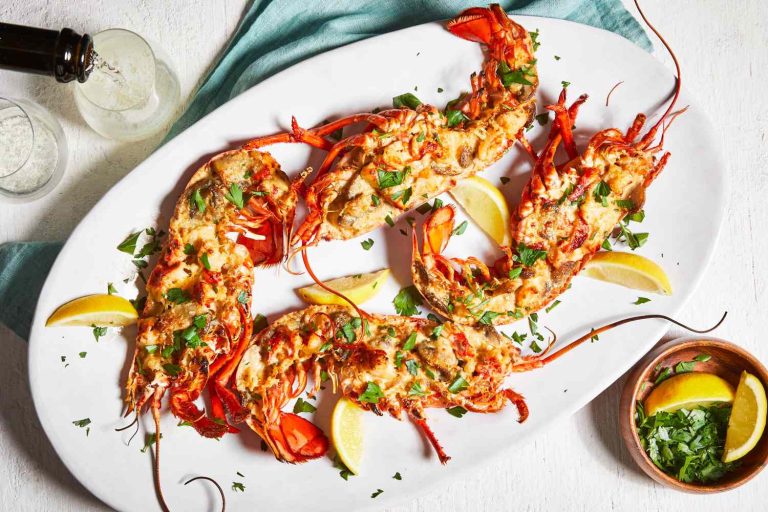The Surprising Benefits of Eating Lobster: Why This Shellfish Deserves a Spot on Your Plate
Long seen as a luxury meal, lobster is frequently connected to special occasions, good dining, and beachside getaways. However, lobster has several nutritional advantages that are sometimes disregarded in addition to its rich flavor and cultural appeal. When eaten in moderation, lobster is a wise addition to a nutritious meal, regardless of whether you prefer it grilled, steamed, or mixed with pasta.
This post will discuss the practical advantages of lobster, how it stacks up against other protein sources, and why it can be a fantastic addition to a varied and conscientious meal.
1. A Lean Source of High-Quality Protein
Lobster is naturally rich in protein — the building block of muscles, tissues, and enzymes. A 3-ounce serving of cooked lobster provides around 17–19 grams of protein, while being relatively low in calories and fat compared to red meat.
Why it matters:
Protein plays a key role in satiety, meaning it helps you feel full longer. This can support mindful eating habits and reduce unnecessary snacking. Additionally, high-quality protein is important for maintaining muscle mass, especially as we age.
2. Low in Saturated Fat
Unlike many red meats or processed meats, lobster is low in saturated fat. This makes it a smart choice for people looking to enjoy flavorful meals without overloading on unhealthy fats.
A quick comparison:
While a burger patty may contain 5–8 grams of saturated fat, the same portion of lobster contains less than 1 gram. This doesn’t mean it should replace all other meats — but it can certainly play a role in a varied diet.
3. Rich in Key Vitamins and Minerals
Lobster is not just protein — it’s also a natural source of several important nutrients:
- Vitamin B12 – Supports brain function and helps produce red blood cells.
- Zinc – Contributes to immune health and wound healing.
- Phosphorus – Important for bone health and energy production.
- Copper – Supports the formation of connective tissue and absorption of iron.
- Selenium – An antioxidant that helps protect cells from damage.
These nutrients are all essential for maintaining overall wellness, and including a variety of seafood in your meals can help meet daily recommended intake levels.
4. Contains Omega-3 Fatty Acids
While lobster doesn’t contain as much omega-3 as fatty fish like salmon or sardines, it still offers a modest amount of these healthy fats. Omega-3 fatty acids have been widely studied for their roles in supporting cardiovascular health, brain function, and inflammation regulation.
Fun fact:
Shellfish like lobster also contain EPA and DHA — the two most beneficial forms of omega-3s, which are more easily used by the body than plant-based sources like flaxseed oil.
5. Low in Carbohydrates
For those following a low-carb or balanced-carb lifestyle, lobster is naturally free from sugars and starches. It’s ideal for pairing with vegetables, whole grains, or salads — allowing for meal flexibility without overcomplicating your plate.
6. Versatile in Recipes
Beyond nutrition, one of the greatest benefits of lobster is how easy it is to incorporate into your meals. You can enjoy it in:
- Soups and stews (like lobster bisque)
- Grilled dishes
- Pasta or risotto
- Lobster rolls
- Tacos or wraps
This makes it a great way to introduce variety into your meals — especially if you’re looking to experiment with seafood without going too far outside your comfort zone.
7. Satisfying Yet Light
1. A Lean Source of High-Quality Protein
Lobster is naturally rich in protein — the building block of muscles, tissues, and enzymes. A 3-ounce serving of cooked lobster provides around 17–19 grams of protein, while being relatively low in calories and fat compared to red meat.
Why it matters:
Protein plays a key role in satiety, meaning it helps you feel full longer. This can support mindful eating habits and reduce unnecessary snacking. Additionally, high-quality protein is important for maintaining muscle mass, especially as we age.
2. Low in Saturated Fat
Unlike many red meats or processed meats, lobster is low in saturated fat. This makes it a smart choice for people looking to enjoy flavorful meals without overloading on unhealthy fats.
A quick comparison:
While a burger patty may contain 5–8 grams of saturated fat, the same portion of lobster contains less than 1 gram. This doesn’t mean it should replace all other meats — but it can certainly play a role in a varied diet.
3. Rich in Key Vitamins and Minerals
Lobster is not just protein — it’s also a natural source of several important nutrients:
- Vitamin B12 – Supports brain function and helps produce red blood cells.
- Zinc – Contributes to immune health and wound healing.
- Phosphorus – Important for bone health and energy production.
- Copper – Supports the formation of connective tissue and absorption of iron.
- Selenium – An antioxidant that helps protect cells from damage.
These nutrients are all essential for maintaining overall wellness, and including a variety of seafood in your meals can help meet daily recommended intake levels.
4. Contains Omega-3 Fatty Acids
While lobster doesn’t contain as much omega-3 as fatty fish like salmon or sardines, it still offers a modest amount of these healthy fats. Omega-3 fatty acids have been widely studied for their roles in supporting cardiovascular health, brain function, and inflammation regulation.
Fun fact:
Shellfish like lobster also contain EPA and DHA — the two most beneficial forms of omega-3s, which are more easily used by the body than plant-based sources like flaxseed oil.
5. Low in Carbohydrates
For those following a low-carb or balanced-carb lifestyle, lobster is naturally free from sugars and starches. It’s ideal for pairing with vegetables, whole grains, or salads — allowing for meal flexibility without overcomplicating your plate.
6. Versatile in Recipes
Beyond nutrition, one of the greatest benefits of lobster is how easy it is to incorporate into your meals. You can enjoy it in:
- Soups and stews (like lobster bisque)
- Grilled dishes
- Pasta or risotto
- Lobster rolls
- Tacos or wraps
This makes it a great way to introduce variety into your meals — especially if you’re looking to experiment with seafood without going too far outside your comfort zone.
7. Satisfying Yet Light
Despite its rich taste, lobster has a surprisingly light texture and doesn’t leave you feeling weighed down. This makes it ideal for lunch or dinner, especially in warmer weather or during active days.
8. Enjoyed Best in Moderation
While lobster offers many nutritional advantages, it’s important to be mindful of portion sizes and preparation methods. Butter-drenched lobster tails or heavy cream sauces can add extra calories and fats. For a more balanced option, try:
- Steamed lobster with lemon
- Grilled lobster with herbs and olive oil
- Lobster salad with mixed greens and vinaigrette
This way, you get the benefits of the lobster itself — without overshadowing them with heavy extras.
9. Supports Coastal Economies and Sustainable Fishing
When sourced responsibly, lobster can also contribute to sustainable food practices and support fishing communities. Look for lobster certified by sustainable seafood organizations, or ask your seafood supplier about the source.
This not only ensures quality — it also contributes to a healthier planet and fairer food systems.
Final Thoughts: Is Lobster Worth Adding to Your Diet?
If you enjoy seafood and are looking for a nutritious, high-protein meal option, lobster is definitely worth considering. It offers a great balance of taste, texture, and nutrition — and with so many ways to prepare it, you’re never stuck with just one recipe.
As with all foods, moderation and balance are key. By pairing lobster with wholesome ingredients and mindful preparation, you can enjoy all the benefits it offers while maintaining a healthy lifestyle.
So next time you’re planning a special meal — or even a regular weeknight dinner — don’t overlook lobster. It’s more than just a treat; it can be a tasty and rewarding part of a well-rounded approach to eating.
While lobster offers many nutritional advantages, it’s important to be mindful of portion sizes and preparation methods. Butter-drenched lobster tails or heavy cream sauces can add extra calories and fats. For a more balanced option, try:
- Steamed lobster with lemon
- Grilled lobster with herbs and olive oil
- Lobster salad with mixed greens and vinaigrette
This way, you get the benefits of the lobster itself — without overshadowing them with heavy extras.
9. Supports Coastal Economies and Sustainable Fishing
When sourced responsibly, lobster can also contribute to sustainable food practices and support fishing communities. Look for lobster certified by sustainable seafood organizations, or ask your seafood supplier about the source.
This not only ensures quality — it also contributes to a healthier planet and fairer food systems.
Final Thoughts: Is Lobster Worth Adding to Your Diet?
If you enjoy seafood and are looking for a nutritious, high-protein meal option, lobster is definitely worth considering. It offers a great balance of taste, texture, and nutrition — and with so many ways to prepare it, you’re never stuck with just one recipe.
As with all foods, moderation and balance are key. By pairing lobster with wholesome ingredients and mindful preparation, you can enjoy all the benefits it offers while maintaining a healthy lifestyle.
So next time you’re planning a special meal — or even a regular weeknight dinner — don’t overlook lobster. It’s more than just a treat; it can be a tasty and rewarding part of a well-rounded approach to eating.







